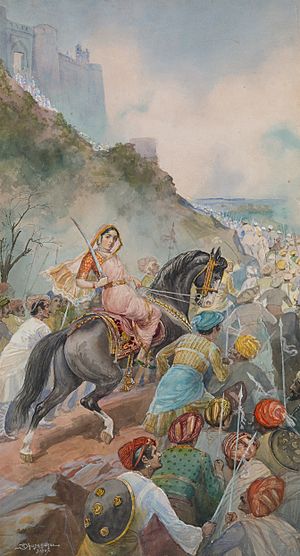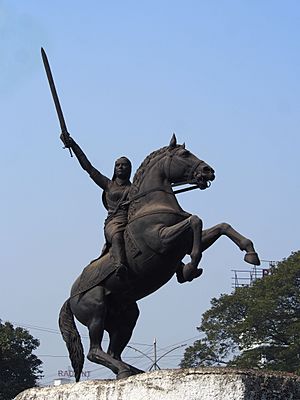Tarabai facts for kids
Quick facts for kids Tarabai |
|
|---|---|
| Regent of the Maratha Empire
Maharani of the Maratha Empire |
|

A 1927 depiction of Tarabai in battle by noted Marathi painter M. V. Dhurandhar
|
|
| Queen Regent of Maratha Empire | |
| Reign | 1700–1708,1710-1714,1751-1760 |
| Born | 1675 |
| Died | 1761 (aged 85–86) Satara |
| Spouse | Rajaram |
| Issue | Shivaji II |
| Father | Hambirao Mohite |
| Religion | Hinduism |
Tarabai Bhosale was a very important queen in Indian history. She was the queen of Rajaram Bhonsale. He was the son of Shivaji, who founded the Maratha Empire. Tarabai became the regent (a ruler for a young king) of the Maratha Empire from 1700 to 1708.
She is famous for bravely leading the fight against the Mughal Empire. This happened after her husband, Rajaram, passed away. She made sure the Maratha people kept resisting the Mughals. She also ruled for her young son, Shivaji II, when he was too young to be king.
Contents
Tarabai's Family and Early Life
Tarabai belonged to the Mohite family. Her father was Hambirrao Mohite. He was the Commander-in-Chief for Shivaji, the first king of the Maratha Empire. Hambirrao's sister, Soyarabai, was also a queen of Shivaji. She was the mother of Shivaji's younger son, Rajaram I.
Tarabai married Rajaram in 1682 when she was just 8 years old. She became his second wife. Rajaram ruled the Maratha Empire from 1689 to 1700. This was after his step-brother, Sambhaji, died. Rajaram's first wife, Jankibai, was the empress at that time.
When Rajaram died in March 1700, Tarabai took charge. She announced that her baby son, Shivaji II, would be the next king. He later became known as Shivaji I of Kolhapur. Tarabai then became the regent, ruling on behalf of her young son.
Leading the Maratha Army
As regent, Tarabai led the war against the Mughal Empire. The Mughal emperor at the time was Aurangzeb. Tarabai was very skilled at moving her cavalry (soldiers on horseback). She made smart plans during battles. She personally led the Maratha army in their fight against the Mughals.
She even offered a truce to the Mughals. But the Mughal emperor quickly said no. So, Tarabai kept the Maratha resistance going strong. By 1705, the Marathas had crossed the Narmada River. They made small attacks into Malwa and then quickly retreated.
In 1706, Mughal forces captured Tarabai for four days. But she escaped when Maratha soldiers attacked the Mughal camp where she was held. The Maratha country was very happy when Aurangzeb died in 1707. He passed away in Ahmadnagar.
A famous Indian historian, Jadunath Sarkar, wrote about these years (1700–1707). He said that Tarabai was the most important leader in Maharashtra. He believed her great leadership and strong character saved the nation during a very difficult time.
Conflict with Shahu
To weaken the Maratha forces, the Mughals released Shahu I. Shahu was Sambhaji's son and Tarabai's nephew. He was released under certain conditions. Shahu immediately challenged Tarabai and her son, Shivaji II, for control of the Maratha kingdom.
Shahu eventually won this power struggle. He pushed Tarabai aside because he had a stronger claim to the throne. Also, Peshwa Balaji Vishwanath used his diplomatic skills to help Shahu. In 1709, Tarabai set up her own rival court in Kolhapur. She made her son, Shivaji II, the first king of Kolhapur. He was known as Shivaji I of Kolhapur.
However, in 1714, Rajaram's other wife, Rajasabai, removed Shivaji I of Kolhapur from power. She put her own son, Sambhaji II, on the throne instead. Sambhaji II then imprisoned Tarabai and her son. Shivaji I of Kolhapur died in 1726. Later, in 1730, Tarabai made peace with Shahu I. She went to live in Satara, but she no longer had any political power.
Dispute with Balaji Baji Rao
In the 1740s, during the last years of Shahu's life, Tarabai introduced a young man to him. She claimed he was her grandson. This would make him a direct descendant of Shivaji. She said that this grandson, named Rajaram, had been hidden after birth for his safety. She claimed he was raised by a soldier's wife. Shahu did not have a son of his own. So, he adopted the young man. This young man later became king as Rajaram II.
After Shahu died in 1749, Rajaram II became the Chhatrapati (king). When Balaji Baji Rao left for the Mughal border, Tarabai told Rajaram II to remove Balaji Baji Rao from his position as Peshwa (prime minister). When Rajaram refused, Tarabai imprisoned him in a dungeon in Satara. This happened on November 24, 1750. She also claimed that he was not her grandson and that she had lied to Shahu.
Earlier, in October 1750, Tarabai met Umabai Dabhade. Umabai also had a disagreement with the Peshwa. Umabai sent 15,000 soldiers led by Damaji Rao Gaekwad to help Tarabai. Gaekwad defeated a force of 20,000 soldiers led by Trimbakrao Purandare. Purandare was loyal to the Peshwa. This battle took place at Nimb, a small town north of Satara. Gaekwad then marched to Satara, where Tarabai welcomed him.
However, Trimbakrao gathered his army again. On March 15, he attacked Gaekwad's army. Gaekwad's soldiers were camped by the Venna River. Gaekwad lost this battle and had to retreat with many losses.
Meanwhile, Balaji Baji Rao returned from the Mughal border. He reached Satara on April 24. He attacked the Yavateshwar fort in Satara and defeated Tarabai's forces. He surrounded the Satara fort and asked Tarabai to release Rajaram II. Rajaram II's health had become very poor. Tarabai refused to release him. Balaji Baji Rao then left for Pune. It would have been very difficult to besiege the strong Satara fort. At the same time, Damaji Gaekwad, Umabai Dabhade, and their relatives were arrested by the Peshwa's men.
Some of Tarabai's soldiers in the Satara fort rebelled against her. She executed their leader, Anandrao Jadhav. However, she realized she could not defeat Balaji Baji Rao. So, she agreed to meet him in Pune for a peace agreement. Janoji Bhonsle, who was also a rival of Balaji Baji Rao, was near Pune with a strong army. He agreed to protect Tarabai.
In Pune, Balaji Baji Rao treated her with respect. After some hesitation, Tarabai accepted Balaji Baji Rao's authority. She agreed to remove her assistant, Baburao Jadhav, whom Balaji Baji Rao disliked. In return, Balaji Baji Rao forgave her. On September 14, 1752, they both made promises at the Khandoba temple in Jejuri. They promised to have peace between them. At this ceremony, Tarabai also swore that Rajaram II was not her grandson. Even so, Balaji Baji Rao kept Rajaram II as the king, but he had no real power.
See also
 In Spanish: Tarabai del Imperio maratha para niños
In Spanish: Tarabai del Imperio maratha para niños


